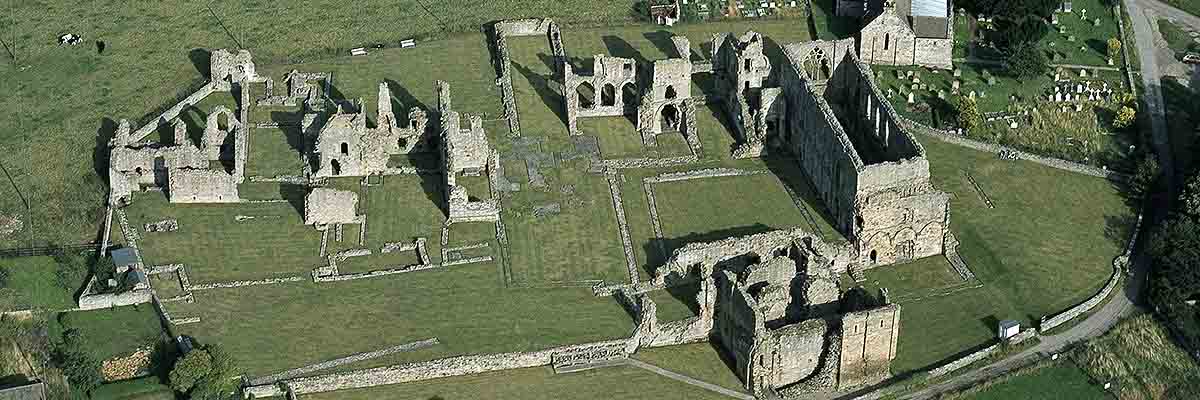Research on Easby Abbey
Much of our current understanding of Easby Abbey derives from the work of William St John Hope, who excavated it in the 1880s. More recent work on the Premonstratensian canons has enhanced our understanding of this distinctive order. Further documentary research, however, could shed considerable light on the abbey’s history.

Early Research
The first general historical account of Easby Abbey seems to be in TD Whitaker’s History of Richmondshire (1823). In 1832, Sir Nicholas Harris Nicolas’s account of the Scrope-Grosvenor controversy of the 1390s brought to light valuable descriptions of the Scrope monuments and other features in the abbey church.[1]
In 1852 the Revd James Raine published the next scholarly account of the abbey.[2] To Whitaker and Nicolas’s discoveries he added some of his own, mainly relating to the Scrope family.
Raine’s paper was accompanied by a short description of the site by the Revd James Turner, who made the first attempt to draw a plan of the site. The Revd George Rowe published a more detailed description of the ruins in 1869, without a historical account but with a plan of the visible remains.[3]
The most important advance in understanding Easby was made by William St John Hope, who excavated a large part of the abbey with support from the Yorkshire Archaeological Society in 1885–6. Hope’s article greatly expanded Turner and Rowe’s accounts and corrected several misapprehensions.[4]
Hope had great experience in investigating Premonstratensian sites. While some of his interpretations of the use and nature of different parts of the site may seem overly confident in the light of Easby’s very unusual layout, they were made on the basis of profound and, at the time, unrivalled knowledge. Hope’s interpretation of Easby Abbey has generally been followed since.
Later Research
There have been three major advances in the understanding of the abbey’s history since Hope’s time.
The first was the publication of the North Yorkshire volumes of the Victoria County History.[5] This established the local historic context in detail.
The second was the publication in 1936 of volumes 4 and 5 of Early Yorkshire Charters, covering the honour of Richmond.[6] Volume 4 includes about 100 documents from the abbey’s cartulary. The cartulary itself has never been published in full. Volume 5 of Early Yorkshire Charters contains several more documents relating to Easby.
The third advance was the publication of Howard Colvin’s ground-breaking study The White Canons in England (1951). This established a clear narrative for the history of the Premonstratensians in England for the first time, providing a short history for each of their houses and placing Easby’s history in the context of its own order.
Future Research Questions
A number of questions about the abbey’s history may be answerable by further documentary research and archaeological investigation:
- Can further light be shed on the constable Roald and his antecedents?
- Why did Roald’s descendants sell their property in Richmondshire, including the patronage of Easby, to the Scropes in the early 14th century?
- Can the abbey’s estates be reconstructed?
- How was the abbey able to afford the reconstruction of its refectory in the later 13th century, and what were the motives for this rebuilding?
- Did the Scrope family pay for the remodelling of the east cloister range in the later Middle Ages? Did they influence its form?
- Did any part of the abbey buildings remain in use after the Suppression?
- Were the abbey ruins deliberately preserved or repaired as an antiquarian object in the 18th or 19th centuries?
- How was the grand apartment in the east range above the chapter house used?
- How was the elaborate north range used?
- How were the grand apartments in the cloister west range used?
- Is there any evidence for the Saxon settlement of Easby? Is there any evidence for the earlier minster on or near the site of the abbey or the present parish church?
- Is it possible to trace the line of the abbey precinct wall? Can the layout of the precinct be established by remote survey or other means?
- Is it possible to trace the abbey’s water supply and management system in detail?
READ MORE ABOUT EASBY ABBEY
Footnotes
1. NH Nicolas, The Controversy between Sir Richard Scrope and Sir Robert Grosvenor 1385–1390, 2 vols (London, 1832).
2. J Raine, ‘On Easby Abbey’, Associated Architectural Societies Reports and Papers, 2 (1853), 316–30.
3. G Rowe, ‘The abbey of St Agatha, for white or Augustine canons, called Praemonstratensians, at Easby’, Associated Architectural Societies Reports and Papers, 10 (1869–70), 57–65.
4. W St J Hope, ‘On the Praemonstratensian abbey of St Agatha juxta Richmond’, Yorkshire Archaeological and Topographical Journal, 10 (1889), 117–58.
5. W Page (ed), A History of the County of York: North Riding, vol 2 (London, 1923) (accessed 13 Feb 2013).
6. W Farrer and CT Clay (eds), Early Yorkshire Charters, vols 4 and 5: The Honour of Richmond (Leeds, 1935–6).